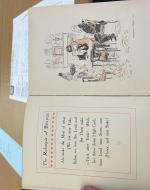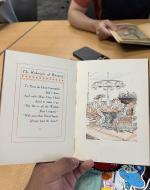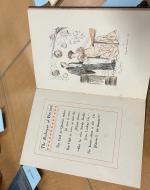Created by Andres Santos on Mon, 05/01/2023 - 16:25
Description:
In On Exhibit: Victorians and Their Museums, written by Barbara Black, she argues that the concept of a gift book has a unique relationship with orientalism. According to the Oxford Languages Dictionary, orientalism is defined as “style, artifacts, or traits considered characteristic of the peoples and cultures of Asia” (Oxford Languages Dictionary). On top of this, orientalism is a way to maintain power; in the sense that people already have a grasp as to how the Asian culture operates. Black believes that giftbooks are partially responsible for this. One book that Black mentions in particular is Edward Fitzgerald’s The Rubáiyát of Omar Khayyam, which made its way around the world by being gifted as a giftbook.
A gift book is exactly as it sounds; it is a book that is meant to be given as a gift to someone, with it being somewhat personalized to the person receiving the gift. In On Exhibit: Victorians and Their Museums, when Black is talking about Fitzgerald’s Rubáiyát of Omar Khayyam, she writes, “The many inscriptions inside the books’ covers attest to the poem’s status as a gift book among family and friends. Elaborately designed gilt covers…and ornamental title pages indicate the poem’s status as treasure book” (Black, 59-60). Black thinks that this gift book has a tie in with orientalism and the power dynamic because it made its way around Western culture. Black says, "The Rubáiyát's crticical reception repeats the pattern of its popular consumption, perhaps more evident in the self-satisfied body of Western criticism the Rubáiyát has generated and substained" (Black, 60). Black also said, "Khayyám's verse remains entrenched in the categorically Oriental, in the land of seers and Eastern serenity; it persists, a bit of wisdom literature that one can hold in one's hand" (Black, 61). However, not every giftbook has a tie in with orientalism.
While Fitzgerald’s Rubáiyát may have had an impact on orientalism, I think that my edition, The Rubáiyát of Bridge by Carolyn Wells, doesn’t align with this particular argument, mainly because this Rubáiyát is about the card game of bridge, which is a mostly westernized card game, and not so much about Asian cultures and traditions. Throughout the Rubáiyát itself, there are references to Western culture and the game of bridge itself, such as different scenarios that bridge players would be in. However, as seen in Figure One, The Rubáiyát of Bridge by Carolyn Wells would be a great example of a giftbook, because there is plenty of room to write personalized notes/messages for the person receiving the gift book, which is an important component of a giftbook.
For example, Figure two in The Rubáiyát of Bridge reads “To Them the Heart Convention did I show, And with Mine Own Hand tried to make it go. But this is all the Wisdom that I reaped,- ‘With more than Three Hearts, always lead the Low’! (Wells). And on this particular page, the picture that is next to the poem is of three women sitting around a table, playing a card game, presumably a game of bridge. As mentioned before, this section of the rubaiyat could be relatable to people, particularly women, who have played bridge in a group setting, which is normally how the game of bridge was played. Another thing to note here is that the word “Hearts” is used here as a reference to the heart cards that are used in the game of bridge. Of course, this is a reference that bridge users would get as well.
Another example that comes to mind is Figure three in The Rubáiyát of Bridge that reads, “The Card no Question makes of ayes and noes, but High or Low, as suits the Player shows; But he who Stands Beside you, Looking on,- He knows about it all! He Knows !! He Knows!! (Wells). This poem was my particular favorite because the picture that is next to this poem is of a woman holding a hand of cards, while a man, probably her husband, is looking over her shoulder. Again, this is a setting that people would be familiar with when it came to playing bridge.
But in terms of thinking about cultural translation and a power relationship, I think that this giftbook shows the power relationship between western culture and the game of bridge, not so much between orientalism and western culture. I would say that this Rubáiyát can teach people from nonwestern culture about the game of bridge. As mentioned earlier, there are a ton of references to the game of bridge, and what it is expected to look like in a group entertainment setting. Perhaps this Rubáiyát can help paint a visual picture for people who may not be familiar with the game of bridge, and at least teach people about some of the rules and terminology used when playing the game of bridge. Not only that, but this Rubáiyát can teach people how western culture operates in general. Whether it be how they play card games, or how they approach social situations in group entertainment settings, this Rubáiyát can help teach people about how some of Western culture might operate.




